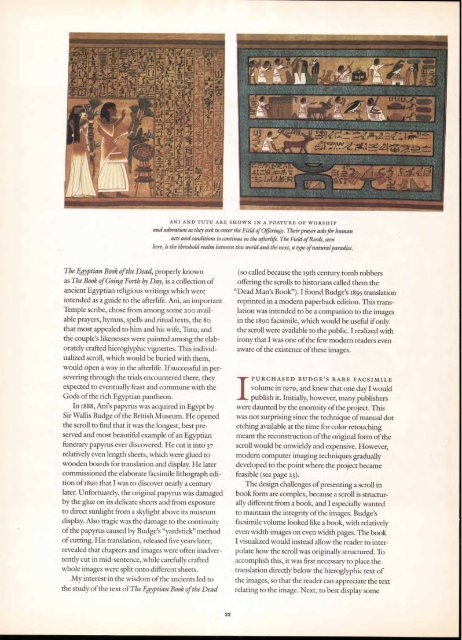You also want an ePaper? Increase the reach of your titles
YUMPU automatically turns print PDFs into web optimized ePapers that Google loves.
The Egyptian Book of the Dead, properly known<br />
as The Book of Going Forth by Day, is a collection of<br />
ancient Egyptian religious writings which were<br />
intended as a guide to the afterlife. Ani, an important<br />
Temple scribe, chose from among some zoo available<br />
prayers, hymns, spells and ritual texts, the 8o<br />
that most appealed to him and his wife, Tutu, and<br />
the couple's likenesses were painted among the elaborately<br />
crafted hieroglyphic vignettes. This individualized<br />
scroll, which would be buried with them,<br />
would open a way in the afterlife. If successful in persevering<br />
through the trials encountered there, they<br />
expected to eventually feast and commune with the<br />
Gods of the rich Egyptian pantheon.<br />
In 1888, Ani's papyrus was acquired in Egypt by<br />
Sir Wallis Budge of the British Museum. He opened<br />
the scroll to find that it was the longest, best preserved<br />
and most beautiful example of an Egyptian<br />
funerary papyrus ever discovered. He cut it into 37<br />
relatively even length sheets, which were glued to<br />
wooden boards for translation and display. He later<br />
commissioned the elaborate facsimile lithograph edition<br />
of 1890 that I was to discover nearly a century<br />
later. Unfortuately, the original papyrus was damaged<br />
by the glue on its delicate sheets and from exposure<br />
to direct sunlight from a skylight above its museum<br />
display. Also tragic was the damage to the continuity<br />
of the papyrus caused by Budge's "yardstick" method<br />
of cutting. His translation, released five years later,<br />
revealed that chapters and images were often inadvertently<br />
cut in mid-sentence, while carefully crafted<br />
whole images were split onto different sheets.<br />
My interest in the wisdom of the ancients led to<br />
the study of the text of The Egyptian Book of the Dead<br />
ANI AND TUTU ARE SHOWN IN A POSTURE OF WORSHIP<br />
and adoration as they seek to enter the Field of Offerings. Their prayer asks for human<br />
acts and conditions to continue in the afterlife. The Field ofReeds, seen<br />
here, is the threshold realm between this world and the next, a type of natural paradise.<br />
22<br />
(so called because the 19th century tomb robbers<br />
offering the scrolls to historians called them the<br />
"Dead Man's Book"). I found Budge's 1895 translation<br />
reprinted in a modern paperback edition. This translation<br />
was intended to be a companion to the images<br />
in the 1890 facsimile, which would be useful if only<br />
the scroll were available to the public. I realized with<br />
irony that I was one of the few modern readers even<br />
aware of the existence of these images.<br />
T PURCHASED<br />
BUDGE'S RARE FACSIMILE<br />
volume in 1979, and knew that one day I would<br />
publish it. Initially, however, many publishers<br />
were daunted by the enormity of the project. This<br />
was not surprising since the technique of manual dot<br />
etching available at the time for color retouching<br />
meant the reconstruction of the original form of the<br />
scroll would be unwieldy and expensive. However,<br />
modern computer imaging techniques gradually<br />
developed to the point where the project became<br />
feasible (see page 23).<br />
The design challenges of presenting a scroll in<br />
book form are complex, because a scroll is structurally<br />
different from a book, and I especially wanted<br />
to maintain the integrity of the images. Budge's<br />
facsimile volume looked like a book, with relatively<br />
even width images on even width pages. The book<br />
I visualized would instead allow the reader to interpolate<br />
how the scroll was originally structured. To<br />
accomplish this, it was first necessary to place the<br />
translation directly below the hieroglyphic text of<br />
the images, so that the reader can appreciate the text<br />
relating to the image. Next, to best display some

















